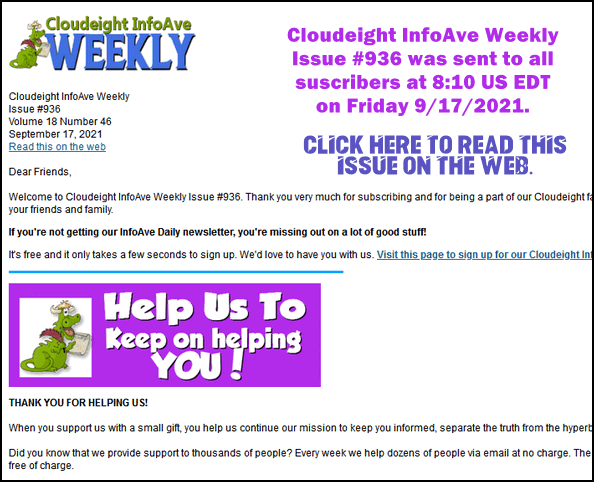Cloudeight InfoAve Weekly – Issue #936 – Available Online
Cloudeight InfoAve Weekly, Issue #936, was sent to all our subscribers on Friday, September 17, 2021, at approximately 8:10 AM, Eastern daylight time (USA).
If you didn’t receive our latest newsletter, it’s because your ISP didn’t deliver it… or it’s in your spam folder. If you are having problems receiving our weekly InfoAve Weekly newsletters, that you subscribe to our newsletter using a free Gmail or Outlook.com account. Both providers allow you to receive mail without censoring your email. If it’s in your spam folder, highlight it, and mark it “Not spam”.
If you’re not a subscriber or if you’re not getting our weekly newsletter and you’d like to, please join us by subscribing to our Cloudeight InfoAve Weekly newsletter here. It’s free and we will never share your email address with anyone for any reason.
You can read Cloudeight InfoAve Weekly – Issue #936 – September 17, 2021, here.
Missed an issue? Visit our Cloudeight InfoAve Weekly Home Page
Our Cloudeight InfoAve Weekly Home Page features the current and recent issues of InfoAve Weekly. Currently, on our InfoAve Weekly Home Page, you’ll find Issues #919 through #936.
If you’ve missed an issue, visit our InfoAve Weekly Home Page and catch up!
If you’re not a subscriber to Cloudeight InfoAve Weekly Newsletter, please join us. It’s delivered to your inbox every Friday and it’s completely free! Subscribe right now!
ARE YOU GETTING OUR DAILY NEWSLETTER?
If you’re not getting our InfoAve Daily newsletter, you’re missing some great tips, tricks, and articles. It’s free and you can subscribe here. It’s short and sweet and we send it every night around 9:00 PM (U.S. Eastern time). Please sign up for our daily newsletter here.
Thank you for visiting us today!
Our small business depends on donations from readers like you. Please help if you can.




Please do an article on “Dropbox” scams. I recently received two from a friend a week apart, in my Hotmail, & I immediately became suspicious. It wasn’t his usual way to communicate, & ‘hovering” over his name showed his actual email address. I sent him a separate email asking if he was using “Dropbox” & he wasn’t. Googling “Dropbox 2021” proved my suspicions.
Now here are my questions: If I block (or mark as “phishing”) this faked sender of a Dropbox message, will that also block my friend’s e-mail? Secondly: does anything actually happen when an email is marked as “phishing”?
Emsisoft, etc is not identifying these fakers.
Thanks for your MANY informative articles, as well as the little laughs & trips down memory lane you frequently insert.
Kathy